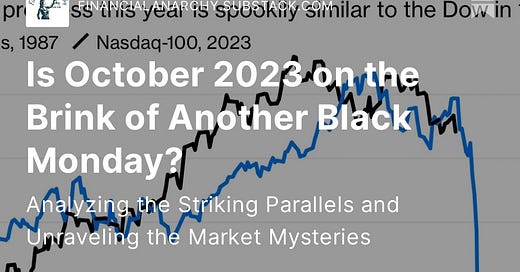Is October 2023 on the Brink of Another Black Monday?
Analyzing the Striking Parallels and Unraveling the Market Mysteries
Introduction:
A recent report has emerged, drawing unsettling parallels between the current financial landscape and the notorious Black Monday of 1987. As we navigate through the intricacies of market trends and historical echoes, the burning question arises: Are we teetering on the edge of another October stock market crash in 2023?
Dow vs. NASDAQ
Let's begin by dissecting the Dow versus the NASDAQ, journeying back to the financial rollercoaster of 1987. The charts unveil a curious dance of market indices, with eerie similarities between the past and the present. The NASDAQ in 2023 mirrors the trajectory of the Dow in 1987, raising eyebrows and prompting deeper exploration.
Bloomberg's Insights
Venturing into a report from Bloomberg, we delve into the events leading to the 1987 Black Monday crash. Insights from financial circles warn against comparisons, yet hints of déjà vu linger. Bond yields and stock market resilience become focal points. The report unearths a historical narrative where rising bond yields, coupled with equity exuberance, set the stage for a catastrophic unraveling.
Examining Numbers and Variables
The report cites examples from 2023, exploring the NASDAQ's current standing and the potential ramifications. A plunge akin to Black Monday could mean a significant downturn. Beyond the surface, we scrutinize variables that fueled the 1987 crash, questioning whether an identical setup looms over October 2023.
Global Monetary Dynamics
In a pivot to global monetary intricacies, a pivotal player in the potential market turmoil. His precarious balance sheet, tethered to dollar-denominated assets and liabilities, unravels a tale of vulnerability. The rise in treasury yields emerges as a critical factor, intertwining with global liquidity dynamics, potentially triggering a domino effect.
Dollar Dynamics and Liquidity Impact
Understanding the global monetary system, we explore how the surge in treasury yields can disrupt the delicate balance. As entities grapple with the need to sell treasuries, the potential reduction in available dollar liquidity becomes a looming threat. This, coupled with a strengthening dollar and surging commodity prices, unveils a complex web influencing the markets.
Dow vs. NASDAQ: A Historical Ballet Unveiled
In the intricate world of financial markets, the interplay between indices can often be likened to a complex dance, each step revealing a narrative of economic shifts and investor sentiment. As we embark on this exploration, we focus on the Dow Jones Industrial Average (Dow) and the NASDAQ, tracing their steps back to the tumultuous year of 1987.
Unveiling the Curious Dance: 1987 and 2023
A Glimpse into the Past: 1987 Dow's Parabolic Rise
Setting our stage in the late 1980s, the Dow embarked on a journey marked by exuberance and volatility. The charts from January 1st, 1987, present a visual narrative, capturing the ascent of the Dow with each passing day. The year started with promise, the blue line on the chart soaring, reflecting a staggering 40% gain. Yet, as the months unfolded, a sense of foreboding crept in, culminating in the infamous Black Monday in October. The market, once soaring, crumbled in a matter of days, wiping out the gains amassed throughout the year.
Echoes in the Present: NASDAQ's Familiar Trajectory in 2023
Fast forward to the present day, and the NASDAQ in 2023 echoes the eerie trajectory of the Dow in 1987. The charts align with a disconcerting similarity, leaving analysts and investors alike in a state of heightened alert. The implications of such a parallel are profound — a sense of déjà vu that demands a more profound exploration into the intricacies of market dynamics.
Deeper Exploration: Beyond Surface Resemblance
Correlation or Causation: Unraveling the Mystery
The skeptical voice may argue that charts often exhibit coincidental similarities. Is the mirroring of the NASDAQ's trajectory in 2023 to the Dow's in 1987 merely a correlation or a potential harbinger of events to come? To answer this question, a more profound dive into the variables influencing market behavior is imperative.
Variables and Market Psychology: Unmasking the Unknown
Beyond the visual resemblance lies a realm of market variables — investor sentiment, economic indicators, and geopolitical influences. Understanding the underlying forces that propelled the Dow into a freefall in 1987 is key to deciphering whether the NASDAQ is poised for a similar fate. This entails a meticulous examination of economic indicators, policy decisions, and global dynamics that shaped the narrative in 1987.
Decoding the Dance Steps
The dance between the Dow and the NASDAQ is not merely a visual spectacle but a reflection of the intricate dynamics shaping financial markets. The parallels between 1987 and 2023 go beyond surface-level resemblance, delving into the realm of market psychology and economic forces. As the charts dance in tandem, investors and analysts alike brace for the unfolding narrative, acutely aware that the echoes of the past may be the prelude to a new financial chapter.
Bloomberg's Revelations: Unmasking the Roots of Black Monday
Click HERE TO WATCH →Bloomberg. What Nassim Taleb Did on Black Monday 1987
In the vast landscape of financial analysis, few sources carry the weight and gravitas of Bloomberg. As we plunge into a report from this esteemed institution, our destination is the enigmatic year of 1987, specifically, the events that culminated in the cataclysmic Black Monday. The insights garnered from this exploration reveal a cautionary tale, cautioning against comparisons, yet weaving a narrative of uncanny parallels.
The Warning Whispers: Financial Circles' Cautious Tone
A Glimpse into Financial Circles: Averse to Comparisons
Before delving into the crux of the matter, it is imperative to acknowledge the cautionary whispers from financial circles. Comparisons to the ominous events of 1987 are met with reluctance, a testament to the unique nature of that historical plunge. Yet, as seasoned analysts tread lightly, the echoes of the past beckon, prompting an exploration into the intricate tapestry of market dynamics.
The Dance of Bond Yields and Market Resilience: A Focal Point
Bond Yields: The Silent Harbinger of Chaos
At the heart of Bloomberg's revelations lies the dance between bond yields and market resilience. Bond yields, often regarded as the barometer of economic health, emerge as silent harbingers of impending chaos. The report meticulously traces the trajectory of rising bond yields, dissecting their impact on market psychology and investor behavior.
Equity Exuberance: A Prelude to Disaster
Entwined with the narrative is the theme of equity exuberance. As the markets bask in the glow of exuberance, a dangerous cocktail is concocted. The ascent of stock prices, seemingly unstoppable, collides with the sobering reality of rising bond yields. This collision, as history dictates, can be the precursor to a catastrophic unraveling.
Unearthing Historical Narratives: Black Monday's Genesis
Rising Bond Yields and Equities: A Historical Symbiosis
The report peels back layers of history, unveiling a symbiotic relationship between rising bond yields and escalating equity prices. In the context of 1987, the synergy of these forces set the stage for Black Monday. The once-resilient market crumbled under the weight of its exuberance, leaving a trail of financial turmoil in its wake.
Conclusion: Lessons from the Past, Warnings for the Present
Bloomberg's insights serve as a poignant reminder that history when examined meticulously, offers valuable lessons. The caution against facile comparisons is not a dismissal but an invitation to scrutinize the intricate details. As bond yields take center stage once again, and equity markets exhibit exuberance, the report sounds a warning bell — a call to vigilance in the face of potential echoes from the past.
Examining Numbers and Variables: Unraveling the Threads of Market Dynamics
As we navigate the intricate currents of financial analysis, the spotlight turns to the examination of numbers and variables — a pivotal exploration fueled by a report citing examples from the current year, 2023. The focus is squarely on the NASDAQ, its present standing, and the ominous specter of potential ramifications. The contemplation of a plunge reminiscent of Black Monday instigates a deep dive into the variables that precipitated the 1987 crash, provoking a critical inquiry into whether an identical setup looms over the horizon of October 2023.
Unpacking the NASDAQ's Current Standing
2023: A Landscape of Uncertainty
In the realm of financial markets, 2023 emerges as a landscape marred by uncertainty. The report, as our guide, leads us through the labyrinthine journey of the NASDAQ, revealing its current standing at around 1350, a figure delicately balanced against the backdrop of a tumultuous year. From an initial point near 10,000 at the beginning of the year, the index's trajectory unfolds with a tale of peaks and valleys.
The Ominous Parallel: Black Monday's Ghost Lingers
The prospect of a plunge akin to Black Monday hovers on the horizon, casting a shadow over the NASDAQ's current numerical representation. If history is to serve as a guide, a significant downturn could be in the making. The numbers, while stark, only scratch the surface of a deeper exploration into the intricate web of variables that may be orchestrating this ominous symphony.
Variables from 1987: Echoes or Anomalies?
Questioning the Parallels: 1987's Legacy in 2023
To unravel the enigma, we turn our gaze to the variables that scripted the narrative of the 1987 crash. Was it a confluence of unique circumstances, or do these variables cast long shadows that extend into the present? The parallels between then and now become a canvas for scrutiny, and the report challenges us to dissect the historical factors that triggered a seismic shift in market dynamics.
Discounted Cash Flow Models: A Lingering Influence
One of the key variables scrutinized is the impact of discounted cash flow (DCF) models. The report delves into the intricate dance between interest rates and future cash flows, highlighting how a surge in rates can cast a shadow on stock prices. The legacy of DCF models, once relegated to the annals of financial jargon, emerges as a significant influencer that demands our attention.
Global Monetary Dynamics: Intricacies of Market Turmoil
Rise in Treasury Yields: A Critical Catalyst
The surge in treasury yields emerges as a seismic force, capable of disrupting the delicate equilibrium of the global monetary system. As the Federal Reserve orchestrates a symphony of interest rate adjustments, the repercussions reverberate through the financial ecosystem. Treasury yields, once seemingly benign, become a critical factor, exerting influence far beyond the confines of conventional financial instruments.
Dollar Dynamics and the Looming Threat to Liquidity
Selling Treasuries: A Desperate Maneuver
The interconnectedness of global entities is underscored as they grapple with the imperative need to sell treasuries. This seemingly desperate maneuver, born out of necessity, threatens to unleash a domino effect. The reduction in available dollar liquidity becomes the proverbial storm on the horizon, with implications echoing through the corridors of international finance.
Strengthening Dollar and Surging Commodities
The surge in treasury yields intertwines with the strengthening dollar and the skyrocketing prices of commodities, forming a complex web that exerts an undeniable influence on the markets. The interconnected nature of these elements amplifies the potential for market upheaval.
Conclusion:
The rise in treasury yields, coupled with the intricacies of dollar dynamics and commodity prices, paints a portrait of a complex web that, if disturbed, has the potential to send shockwaves through the global markets. In the impending chapters of this financial saga, vigilance and a nuanced understanding of these dynamics become the compass for those navigating the tumultuous seas of international finance.








